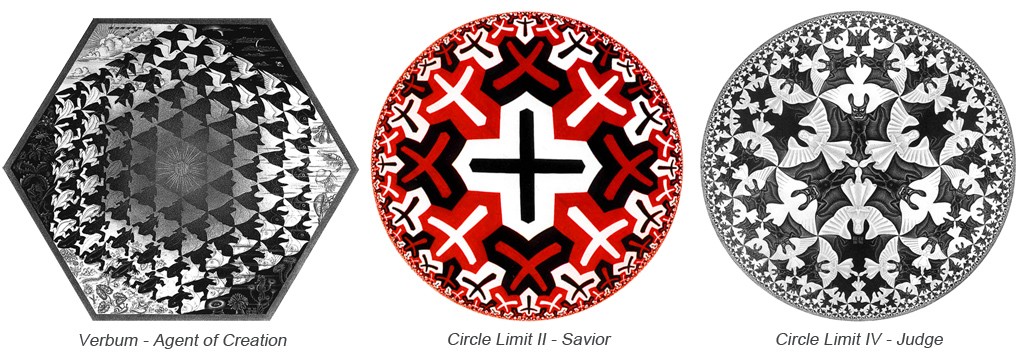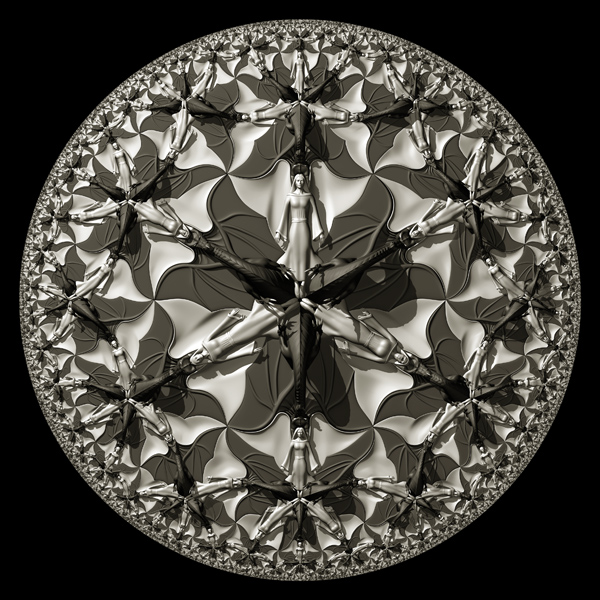One of my favorite artists, M.C. Escher is a Dutch artist and print maker. He created motifs which, when repeated, fill the printed page.
Escher also created roughly two dozen prints with Biblical themes. One finds him returning to specific Biblical themes over the course of his life, rendering them in new ways as he grew as an artist.
Towards the end of Escher’s life, he created a series of Christian mandalas. I created the mandala above as homage to Escher, using Escher’s Circle Limit IV as inspiration. In general mandalas are in a circular format. Symbols are drawn within the circle, usually revolving around a central focus.
Each of the three Christian Mandalas below (one of which is Circle Limit IV) relates to a specific role of Christ. Again, Escher had visited these themes in earlier prints, but came back and rendered those themes in mandala format.

The first mandala is called Verbum, and is formatted as a hexagon, rather than the traditional circle. Other than that, it follows the mandala format. At the very center of the print is the Latin word VERBUM, which means “The Word” in English. In Escher’s lecture notes regarding the print, he writes: “In the center the word VERBUM (‘In principium erat Verbum’) recalls the biblical story of creation.” The full Latin phrase translates as: “In the beginning was the Word.” In this mandala, Escher has the center focused on Christ, as portrayed in the Gospel of John. In doing this, Escher has Christ representing the focal point and agent of Creation.
The second mandala is officially known as Circle Limit II, and is a mandala of the Cross. Escher writes to his son regarding this piece: “I’ve now started on a woodcut, another round one, with a circular limit using a system I developed myself, which will have an infinite number of crosses in black, red and white. The pope will have to buy it from me for a lot of money. The symbolism is so exaggerated that no one would imagine that I cannot believe in crosses. Amen.”
The last mandala is officially known as Circle Limit IV, although Escher referred to it as Heaven and Hell. This Christian mandala depicts an infinite number of angels and devils. Look at the composition as angels in the foreground and devils in the background. Viewed this way, one can consider the realms these two creatures inhabit as infinite, yet forever separate. Technically, you could swap and have Hell in the foreground and Heaven in the background, but let’s have the main focus on the place we’re all trying to get to!
Escher’s worldview is rather interesting. My take is that he was a Christian.
As mentioned before, he created about two dozen prints with Biblical themes. He wasn’t commissioned to create these prints; he wanted to create them.
In the print Verbum, we have Christ’s role as the agent of Creation. In Circle Limit II, we have Christ’s role on the cross as the savior of mankind. In Circle Limit IV, we have Christ’s role as the final judge of mankind. Escher gives us Christ from Genesis to Revelation.
Escher also belonged to a religious order, had his son’s christened, brought his wife into the Roman Catholic Church, and wrote about his church experiences and “Celebrating Easter.”
When referring to other people in his letters, Escher often used the prefix of “Brother” or “Sister” followed by the person’s “Christian” (baptismal) name. For example, Escher refers to Bruno Ernst, who wrote the book: The Magic Mirror of M.C. Escher, as “Brother Erich.”
There are other clues to Escher’s Christian world view in his lecture notes. He had a habit of writing out the text of a lecture before actually presenting it. In these writings, Escher references Genesis, Exodus, and the Gospel. Turns out his favorite story is the Creation story (probably why he was inspired to create Verbum).
When worried, Escher writes of Providence and God’s will. One example is when Escher writes to his son, Arthur, describing a construction project at the family home. Heavy tiles had been stacked on top of the roof, but wouldn’t be installed until the next day. During the night, a storm came up. Escher was concerned that the loose tiles would blow off the roof, and subsequently destroy the windows of his studio. Regarding the incident, Escher writes: “However, Providence seems to have wished to protect our family personally, for the next morning nothing had broken and not one of the stacks had even moved. Science (George [Escher’s oldest son]) explains that this was not a miracle by any means, but as far as I am concerned, the hand of God can be seen in it.”
To learn more about Escher and his Biblical Art, worldview, and application of Christian development, please consider looking at my book: Jesus, Escher, and the Art of Christian Morphing.

